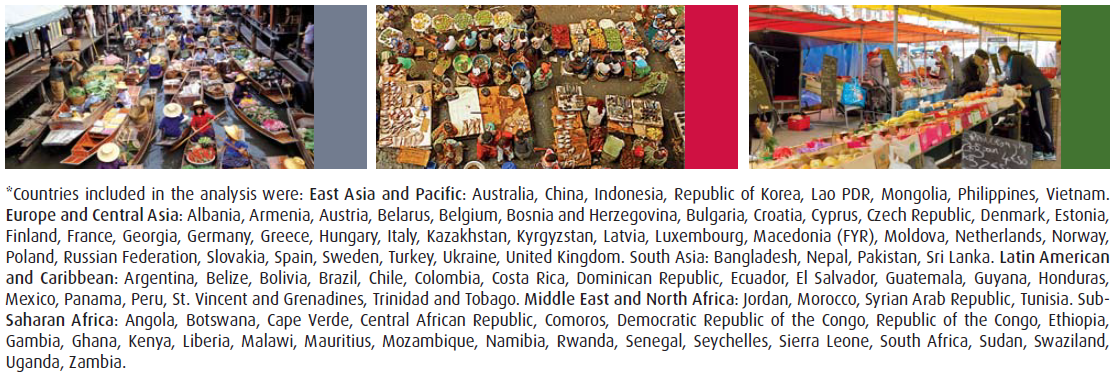Societal Correlates of Diabetes Prevalence: An Analysis Across 94 Countries
In this study, we quantified relationships between societal-level factors and diabetes prevalence. Researchers have previously explored singular relationships between societal factors – such as availability of certain foods, urbanization, passenger cars, motorways, and governance indicators – and Non-Communicable Diseases (NCDs). We sought to advance the field by quantifying relationships between diabetes and multiple socio-economic variables, isolating effects relative to and independent of interactions with other societal-level influences.
A Wide Variety of Sources
We used data from the International Diabetes Federation, World Health Organization, World Bank, and Food and Agricultural Organization. We extracted 2010 estimates for country-level diabetes prevalence and identified country-level estimates for variables known to be associated with diabetes at the individual level: total caloric availability; sugar, animal fat, fruit and vegetable (F&V) availability (determined by food production, imports, and exports); proxies for physical inactivity (vehicles per capita and value-added from service sector); Gross Domestic Product per capita (GDP); imports; and age-adjusted mortality rate. We then used statistical models to investigate cross-sectional relationships between these factors and diabetes prevalence in 94 countries*.
Higher Availability of Fruits and Vegetables Is
Associated with Lower Diabetes Prevalence
Our results indicate significant associations between multiple upstream societal-level indicators and diabetes prevalence, controlling for key factors like GDP per capita (purchasing power parity), mortality rate, and foreign direct investment (a marker of a country’s integration into the global economy and exposure to packaged and processed foods). We estimated that a 10% higher availability of calories from F&V is associated with 30.6% lower diabetes prevalence. On the other hand, 10% lower availability of calories from sugar is associated with 61.5% lower diabetes prevalence and 10% lower availability of calories from animal fat is associated with 29.0% lower diabetes prevalence. Five hundred fewer available calories per person per day is associated with 5.2% lower diabetes prevalence.
What Guidelines to Follow, Concretely?
Without assuming causality, the findings were then put into the context of individuals in a population. For a 2,000 calories daily diet for the average adult individual, our results suggest that increasing F&V consumption by 5% could be accomplished by increasing the availability of F&V by one or two servings per person per day. This increased consumption would be associated with a 17% lower diabetes prevalence. Conversely, shifting daily energy from sugar by 5% would equate to consuming 100 fewer calories of sugar a day – drinking one less can of regular soda per day or eating half a chocolate bar less – and may be associated with 27% lower diabetes prevalence. Shifting daily energy from animal fat by 5% would equate to consuming 100 fewer calories of animal fat per day, and may be associated with 15% lower population diabetes prevalence. In light of the increasing diabetes burden in developing country regions, policies to increase availability of F&V and limit the unfettered availability of sugar, animal fat, and total calories may be worthy of further careful investigation, within a holistic nutrition strategy.
Offer More Fruits and Vegetables to Residents
At the societal level, behavioral changes could be achieved by a wide variety of policy responses. For example, policy action to increase F&V consumption, including distribution (F&V are highly prone to spoiling before they reach their market destination, particularly in warm climates like India or Africa), cost, subsidies, and encouraging consumption at the individual level. Policy action to decrease sugar or animal fat availability and subsequent consumption, or to increase F&V consumption, could also examine trade policies to ensure that economic policies also consider availability and pricing of healthy versus unhealthy foods. In each case, policy responses should be tailored to the country-specific context, considering needs as well as available resources.
The United Nations High-Level Meeting on NCDs and the recently announced specific goal of a 25% reduction in the deaths due to NCDs by 2025 signifies an opportunity to act, encouraging policymakers to tailor country-level socioeconomic development through policies and resource allocation that continue to promote economic development while minimizing the negative health consequences of such development. We hope that our study may provide value through offering a quantitative understanding of the influence of upstream precipitants of diabetes, and guide conversations and future investigations to consider appropriate economic and social policy responses.

